When helping a client move or transfer from place to place, watch out for back and shoulder injuries as well as general aches and pains.
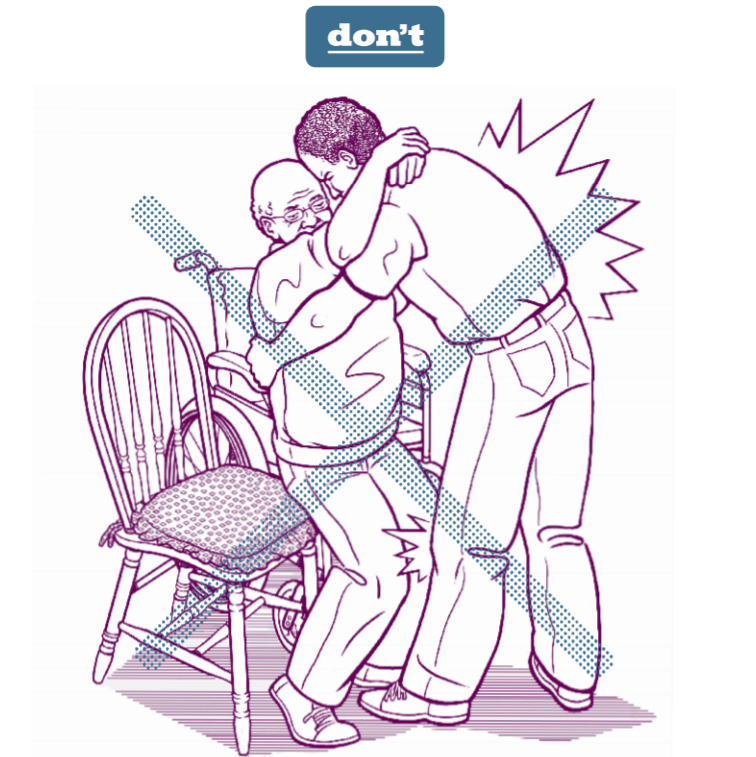
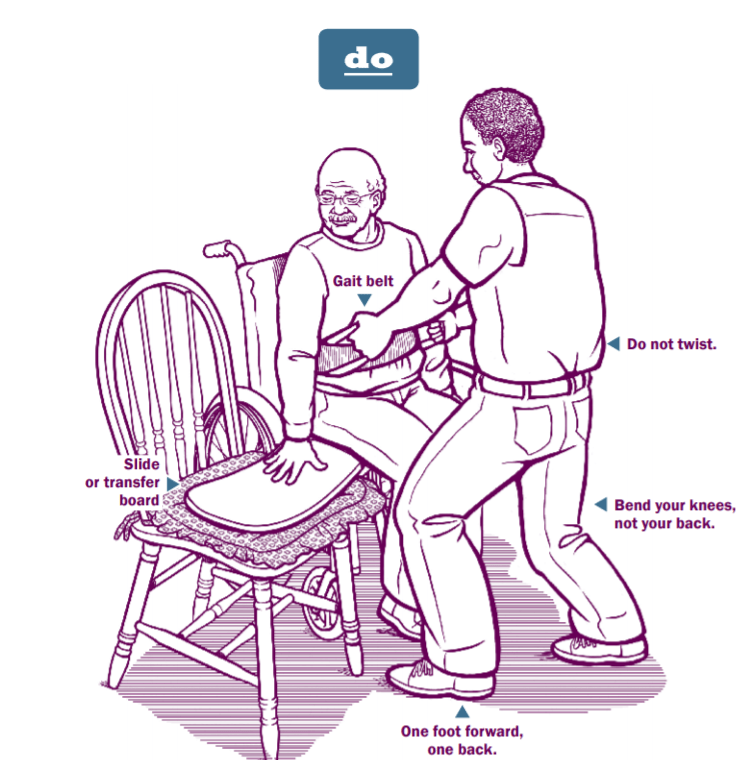
Tools
Use these things to make this work safer:
- A gait belt buckled around the client’s waist is a simple, low-cost way to help with transfers and keep workers from straining their backs.
- A slide or transfer board to help the client move between two locations—such as a wheelchair and bed, or wheelchair and toilet.
- A Hoyer lift, which is a portable device that helps you lift and transfer the client.
- Handrails, grab bars, or vertical poles installed to help the client sit, rise, and stay upright.
- Shower chairs that let the client bathe more safely.
- Raised, lockable toilet seats with support arms to make bathroom visits easier and safer.
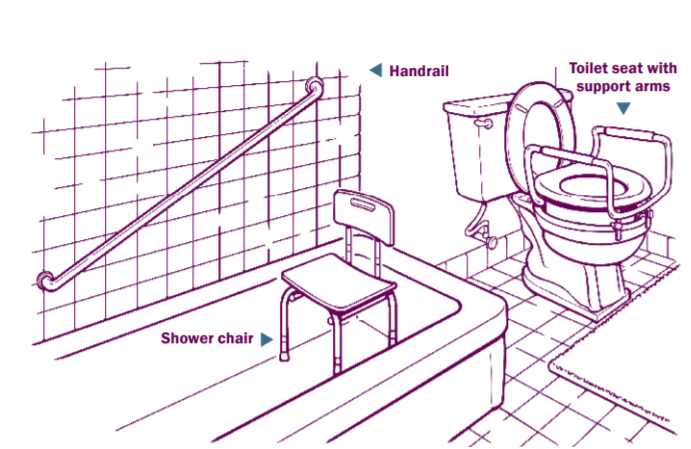
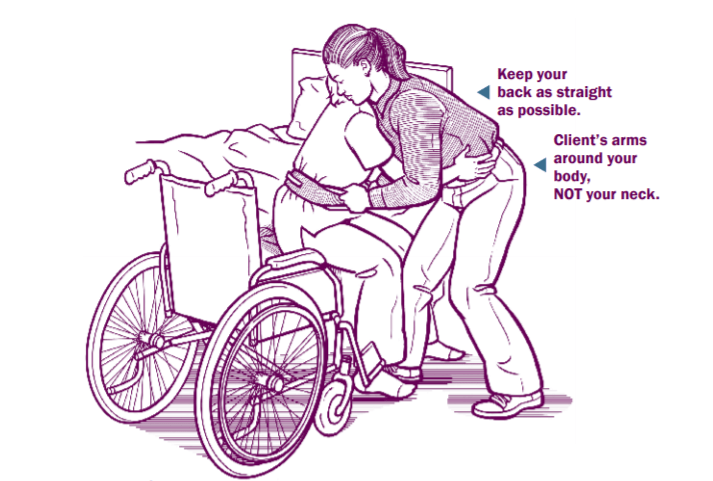
Tips
Use these safe-lifting practices:
- Don’t try anything you think might be unsafe. If needed, get help from another person.
- Keep the client close to your body while you are assisting.
- Bend your knees—not your back—while moving him or her. Do not twist at the waist. Try to turn your whole body.
- Have the client put his or her arms around your body, NOT your neck.
- Do not pull with your arms or your back.
- Keep your feet at least as wide apart as your shoulders.
- Put one foot forward, the other back.
Talk it over
You could say this: “How are you usually moved? Tell me if there if there is anything special I should know. Can we work together to make it safe for my back?”
Please check out How Caregiver and Client Should Talk to Each Other About Safety for related tips for effectively communicating your concerns to each other.
When the client uses a wheelchair
- Push, don’t pull the wheelchair—it’s easier on your back.
- Before helping with a transfer, remove or fold back the leg rests and make sure the brakes on both sides are locked.
- If the wheelchair is motorized, make sure the chair’s power is turned off before the transfer so it doesn’t accidently move and lead to an injury.
If you’re concerned that the client might fall
- Have a plan in mind, including a number to call for help.
- If the client starts to fall, minimize the possibility of injury to both of you by controlling the fall—guiding the client slowly to the floor.
- After making sure that the client is not injured, assist him or her to rise or get help to lift the client.
- If there’s ANY POSSIBILITY the client has been injured, DO NOT MOVE HIM OR HER— CALL 911.
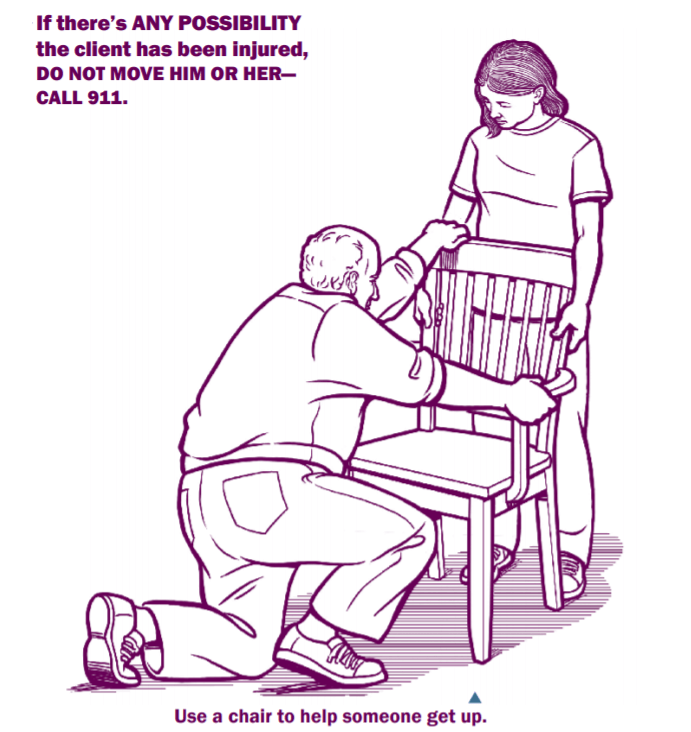
Find help
Equipment
- Clients can ask their doctors about
- getting a wheelchair, walker, cane, or other device to help them move around. Doctors
- can write prescriptions for these devices, sometimes called “durable medical equipment.”
- Centers for Independent Living can also be helpful. Call 713–520–0232 (not toll free) to find a local center in your state. Or visit www.ilru.org.
- The Able Data website also has information about equipment at www.abledata.com.
Training
- Local adult schools or community colleges
- provide Certified Nursing Assistant or homecare worker classes that cover lifting, transfers, and other procedures.
- If the client bought equipment from a medical equipment supply company, the company can show you how to use it.
- If you work for an agency, ask if they have training programs.
- Check with your union, if you have one, to see if they offer training classes.
To make good use of the above tips, we encourage you to keep track of good ideas to make your work safer and fill out your own to do list like the one below.
To do list
Supplies needed:
- Gait belt
- Slide or transfer board
- Hoyer lift
- Handrails, grab bars, or vertical posts
- Shower chair
- Raised, lockable toilet seats with support arms
- Other: __________________________________________
Safety tips you will follow/New ways to do the tasks:
_____________________________________________________________________
_____________________________________________________________________
_____________________________________________________________________
_____________________________________________________________________
Issues you need to discuss:
_____________________________________________________________________
_____________________________________________________________________
_____________________________________________________________________
_____________________________________________________________________
People or organizations to contact for help, tools, or information:
_____________________________________________________________________
_____________________________________________________________________
_____________________________________________________________________
_____________________________________________________________________
Building on the above to do list, you can combine them with other to do lists from the other tips in this series to create your own combined action plan for safety and keep it on hand to remind you both about staying safe.
Reference: “Caring for Yourself While Caring for Others” by Center for Disease Control’s National Institute for Occupational Safety and Health (NIOSH).
* * * * *
Is caring your calling? We’re hiring qualified people committed to helping others. We serve clients in Contra Costa and Alameda Counties, mainly in Danville, Blackhawk, San Ramon, Dublin, Pleasanton, Castro Valley, Hayward, Livermore, and communities along the 680 Corridor of the East Bay. Learn more here.
You may submit an application here.